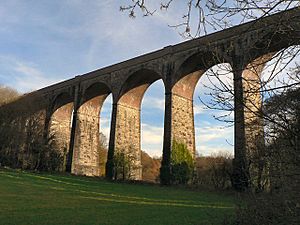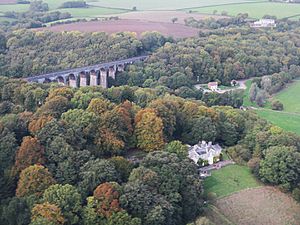Porthkerry Viaduct facts for kids
The Porthkerry Viaduct is a very long railway bridge near Barry in the Vale of Glamorgan, Wales. It was built to carry trains across a valley. This impressive structure has a fascinating history, including some challenges during its construction.
Contents
Building the Porthkerry Viaduct
The Porthkerry Viaduct was designed by engineers James and William Szlumper. The Pethick Brothers company started building it in 1894. Its main purpose was to carry the Vale of Glamorgan Railway. This railway connected Tondu, Bridgend, and the busy Barry Docks.
Construction Challenges
Building such a large bridge was not easy. In August 1896, some of the piers, which are the tall supports for the bridge, started to sink. Pier number 9 sank about 4 feet 6 inches (1.37 meters). Pier number 10 also sank about 3 feet 6 inches (1.07 meters). This caused three of the arches to become twisted. The builders had to take these parts down and rebuild them.
More problems appeared after the viaduct opened on December 1, 1897. Just a few weeks later, the ground at the Barry end of the bridge began to slip. This pushed pier number 15 slightly out of place. Workers had to pack stones around the foundations of piers 13, 14, and 15 to make them stable.
In January 1898, the track above pier number 13 sank. Trains had to stop using the viaduct right away. The pier kept sinking, going down about 13 inches (33 centimeters). A temporary railway line, about 2.5 miles (4 kilometers) long, was quickly built around the valley. This allowed trains to keep running while repairs were made. The company Price and Wills, who had built part of Barry Docks, took over the repair work. The Porthkerry Viaduct finally reopened on January 8, 1900.
Features of the Viaduct
The Porthkerry Viaduct is a large and strong structure. It has sixteen arches in total. Thirteen of these arches are 50 feet (15 meters) wide. The three arches at the Barry end are 45 feet (14 meters) wide. The viaduct stands very tall, reaching a height of 110 feet (34 meters). Today, it stretches across the northwest end of Porthkerry Park. Because of its historical importance, it became a Grade II listed building in 1963. This means it is a special building protected by law.
What the Viaduct is Used For
The Porthkerry Viaduct was originally built to help transport coal. Trains carried large amounts of coal from the mines to Barry Docks, where it was loaded onto ships.
Today, the railway line still carries trains. It is mainly used for passenger services between Cardiff, Cardiff Airport, and Bridgend. Sometimes, freight trains also use this line. It acts as an important alternative route if the main railway line in South Wales needs repairs or maintenance. Heavy coal traffic to Aberthaw Power Station stopped in 2019, as the power station closed down.
A Similar Bridge
The Porthkerry Viaduct was designed to look like another bridge called the Shillamill Viaduct. The Shillamill Viaduct crosses the River Lumburn near Tavistock. However, there are some differences. The Shillamill Viaduct has only 12 arches and is built on a gentle curve. It no longer has train tracks and is also a listed structure.
Art and the Viaduct
A famous watercolour artist named Thomas Frederick Worrall lived in Barry starting in 1913. He was inspired by the local scenery and painted the Porthkerry Viaduct.



